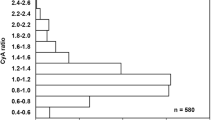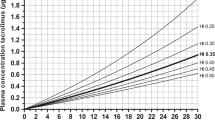Abstract
Background Elevated blood concentration of tacrolimus is frequently observed following transfusion of red blood cell concentrate in patients after allogeneic hematopoietic stem cell transplantation. Objective The aim of this retrospective study was to clarify the effects of transfusion of red blood cell concentrate on the blood concentration of tacrolimus. Setting Chiba University Hospital in Japan. Method Fifty-two patients (aged 0–65 years) receiving both tacrolimus and transfusion after allogeneic hematopoietic stem cell transplantation were enrolled. The ratio of measurement after transfusion to measurement before transfusion was calculated for hematocrit and blood concentration/dose ratio of tacrolimus (termed the hematocrit ratio and the tacrolimus ratio, respectively). Main outcome measure Change in blood concentration/dose ratio of tacrolimus and variable factors associated with variation in tacrolimus ratio. Results The blood concentration/dose ratio of tacrolimus was increased after transfusion compared with before transfusion (p < 0.001). A statistically significant correlation was seen between the hematocrit ratio and tacrolimus ratio (r = 0.32, p < 0.001). Hematocrit ratio, age or body surface area, and difference in aspartate aminotransferase level before and after transfusion were associated with the variation in tacrolimus ratio. There was no correlation between tacrolimus ratio and change in serum creatinine or potassium level in the short term. Conclusion Change in the blood concentration/dose ratio of tacrolimus was associated with change in the hematocrit ratio after transfusion, and more attention is required for children or patients with small body surface area. Dose adjustment of tacrolimus is required if the blood concentration of tacrolimus is much higher than the target concentration.



Similar content being viewed by others
References
Ratanatharathorn V, Nash RA, Przepiorka D, Devine SM, Klein JL, Weisdorf D, et al. Phase III study comparing methotrexate and tacrolimus (prograf, FK506) with methotrexate and cyclosporine for graft-versus-host disease prophylaxis after HLA-identical sibling bone marrow transplantation. Blood. 1998;92:2303–14.
Nash RA, Antin JH, Karanes C, Fay JW, Avalos BR, Yeager AM, et al. Phase 3 study comparing methotrexate and tacrolimus with methotrexate and cyclosporine for prophylaxis of acute graft-versus-host disease after marrow transplantation from unrelated donors. Blood. 2000;96:2062–8.
Hiraoka A, Ohashi Y, Okamoto S, Moriyama Y, Nagao T, Kodera Y, Japanese FK506 BMT(Bone Marrow Transplantation) Study Group, et al. Phase III study comparing tacrolimus (FK506) with cyclosporine for graft-versus-host disease prophylaxis after allogeneic bone marrow transplantation. Bone Marrow Transpl. 2001;28:181–5.
Murata M. Prophylactic and therapeutic treatment of graft-versus-host disease in Japan. Int J Hematol. 2015;101:467–86.
Machida M, Takahara S, Ishibashi M, Hayashi M, Sekihara T, Yamanaka H. Effect of temperature and hematocrit on plasma concentration of FK 506. Transplant Proc. 1991;23:2753–4.
The Japanese Society of Therapeutic Drug Monitoring and the Japanese Society of Transplantation. Guidelines on TDM of immunosuppressive drugs in organ transplantation. 1st ed. Tokyo: Kanehara Publishing Ltd.; 2014.
Siekierka JJ, Hung SH, Poe M, Lin CS, Sigal NH. A cytosolic binding protein for the immunosuppressant FK506 has peptidyl-prolyl isomerase activity but is distinct from cyclophilin. Nature. 1989;341(6244):755–7.
Kay JE, Sampare-Kwateng E, Geraghty F, Morgan GY. Uptake of FK 506 by lymphocytes and erythrocytes. Transplant Proc. 1991;23:2760–2.
Cunningham EB. The human erythrocyte membrane contains a novel 12-kDa inositolphosphate-binding protein that is an immunophilin. Biochem Biophys Res Commun. 1995;215:212–8.
Zahir H, Nand RA, Brown KF, Tattam BN, McLachlan AJ. Validation of methods to study the distribution and protein binding of tacrolimus in human blood. J Pharmacol Toxicol Methods. 2001;46:27–35.
European Tacrolimus Multicentre Renal Study Group, Undre NA, Schäfer A. Factors affecting the pharmacokinetics of tacrolimus in the first year after renal transplantation. Transplant Proc. 1998;30:1261–3.
Minematsu T, Sugiyama E, Kusama M, Hori S, Yamada Y, Ohtani H, et al. Effect of hematocrit on pharmacokinetics of tacrolimus in adult living donor liver transplant recipients. Transplant Proc. 2004;36:1506–11.
United States Pharmacopeial Convention. USP DI (1). Drug information for the Health Care Professional 27th. Massachusetts: Thomson Micromedix; 2007. p. 2674–9.
Nagase K, Iwasaki K, Nozaki K, Noda K. Distribution and protein binding of FK506, a potent immunosuppressive macrolide lactone, in human blood and its uptake by erythrocytes. J Pharm Pharmacol. 1994;46:113–7.
Chow FS, Piekoszewski W, Jusko WJ. Effect of hematocrit and albumin concentration on hepatic clearance of tacrolimus (FK506) during rabbit liver perfusion. Drug Metab Dispos. 1997;25:610–6.
Venkataramanan R, Swaminathan A, Prasad T, Jain A, Zuckerman S, Warty V, et al. Clinical pharmacokinetics of tacrolimus. Clin Pharmacokinet. 1995;29:404–30.
Golubović B, Vučićević K, Radivojević D, Kovačević SV, Prostran M, Miljković B. Total plasma protein effect on tacrolimus elimination in kidney transplant patients–population pharmacokinetic approach. Eur J Pharm Sci. 2014;52:34–40.
Han N, Yun HY, Hong JY, Kim IW, Ji E, Hong SH, et al. Prediction of the tacrolimus population pharmacokinetic parameters according to CYP3A5 genotype and clinical factors using NONMEM in adult kidney transplant recipients. Eur J Clin Pharmacol. 2013;69:53–63.
Zhao W, Elie V, Roussey G, Brochard K, Niaudet P, Leroy V, et al. Population pharmacokinetics and pharmacogenetics of tacrolimus in de novo pediatric kidney transplant recipients. Clin Pharmacol Ther. 2009;86:609–18.
Yonemura Y, Matsumoto M, Inada E, Ueda Y, Ohishi K, Kino S, et al. Guideline for the use of red blood cell products based on scientific evidence. Jpn J Transfus Cell Ther. 2016;62:641–50.
Sattler M, Guengerich FP, Yun CH, Christians U, Sewing KF. Cytochrome P-450 3A enzymes are responsible for biotransformation of FK506 and rapamycin in man and rat. Drug Metab Dispos. 1992;20:753–61.
Kamdem LK, Streit F, Zanger UM, Brockmöller J, Oellerich M, Armstrong VW, et al. Contribution of CYP3A5 to the in vitro hepatic clearance of tacrolimus. Clin Chem. 2005;51:1374–81.
Iwasaki K. Metabolism of tacrolimus (FK506) and recent topics in clinical pharmacokinetics. Drug Metab Pharmacokinet. 2007;22:328–35.
Staatz CE, Willis C, Taylor PJ, Tett SE. Population pharmacokinetics of tacrolimus in adult kidney transplant recipients. Clin Pharmacol Ther. 2002;72:660–9.
Lu YX, Su QH, Wu KH, Ren YP, Li L, Zhou TY, et al. A population pharmacokinetic study of tacrolimus in healthy Chinese volunteers and liver transplant patients. Acta Pharmacol Sin. 2015;36:281–8.
Jacobson P, Ng J, Ratanatharathorn V, Uberti J, Brundage RC. Factors affecting the pharmacokinetics of tacrolimus (FK506) in hematopoietic cell transplant (HCT) patients. Bone Marrow Transplant. 2001;28:753–8.
Wingard JR, Nash RA, Przepiorka D, Klein JL, Weisdorf DJ, Fay JW, et al. Relationship of tacrolimus (FK506) whole blood concentrations and efficacy and safety after HLA-identical sibling bone marrow transplantation. Biol Blood Marrow Transplant. 1998;4:157–63.
Przepiorka D, Nash RA, Wingard JR, Zhu J, Maher RM, Fitzsimmons WE, et al. Relationship of tacrolimus whole blood levels to efficacy and safety outcomes after unrelated donor marrow transplantation. Biol Blood Marrow Transplant. 1999;5:94–7.
Levey AS, Bosch JP, Lewis JB, Greene T, Rogers N, Roth D. A more accurate method to estimate glomerular filtration rate from serum creatinine: a new prediction equation. Modification of Diet in Renal Disease Study Group. Ann Intern Med. 1999;130:461–70.
Levey AS, Coresh J, Greene T, Marsh J, Stevens LA, Kusek JW, Chronic Kidney Disease Epidemiology Collaboration, et al. Expressing the Modification of Diet in Renal Disease Study equation for estimating glomerular filtration rate with standardized serum creatinine values. Clin Chem. 2007;53:766–72.
Matsuo S, Imai E, Horio M, Yasuda Y, Tomita K, Nitta K, Collaborators developing the Japanese equation for estimated GFR, et al. Revised equations for estimated GFR from serum creatinine in Japan. Am J Kidney Dis. 2009;53:982–92.
Schwartz GJ, Work DF. Measurement and estimation of GFR in children and adolescents. Clin J Am Soc Nephrol. 2009;4:1832–43.
Zahir H, McCaughan G, Gleeson M, Nand RA, McLachlan AJ. Factors affecting variability in distribution of tacrolimus in liver transplant recipients. Br J Clin Pharmacol. 2004;57:298–309.
Funding
None.
Conflicts of interest
None of the authors has a relevant financial conflict of interest to disclose in relation to this manuscript.
Author information
Authors and Affiliations
Corresponding author
Additional information
Publisher's Note
Springer Nature remains neutral with regard to jurisdictional claims in published maps and institutional affiliations.
Electronic supplementary material
Below is the link to the electronic supplementary material.
Rights and permissions
About this article
Cite this article
Uchida, M., Yamazaki, S., Suzuki, T. et al. Effects of red blood cell concentrate transfusion on blood tacrolimus concentration. Int J Clin Pharm 42, 956–964 (2020). https://doi.org/10.1007/s11096-020-01038-9
Received:
Accepted:
Published:
Issue Date:
DOI: https://doi.org/10.1007/s11096-020-01038-9




